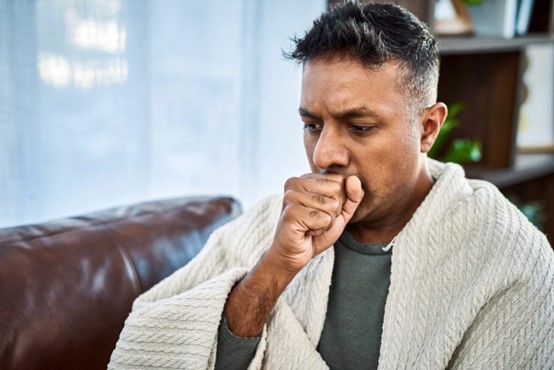 蓋蒂圖片社
蓋蒂圖片社您是否曾經(jīng)患過感冒,一連幾個(gè)星期都無法痊愈,,而它并不是新冠,?
長新冠,指的是感染新冠病毒后出現(xiàn)的長期癥狀,,可持續(xù)數(shù)周,、數(shù)月甚至數(shù)年。
“長感冒”可能也是一種病,。
這是倫敦瑪麗女王大學(xué)(Queen Mary University of London)周五發(fā)表在《柳葉刀》子刊EClinical Medicine雜志上的一項(xiàng)最新研究結(jié)果,。研究人員詢問了數(shù)百名恢復(fù)期長達(dá)四周甚至更長時(shí)間的近期患者,以了解他們的癥狀,。其中一些人最近感染了新冠,,另一些人最近患上了其他某種急性呼吸道疾病,研究人員將其統(tǒng)稱為“感冒”,。這些疾病包括:
? 肺炎
? 流感
? 支氣管炎
? 扁桃體炎
? 咽炎
? 中耳炎
? 普通感冒
最近經(jīng)歷過急性呼吸道感染的患者最常見的癥狀包括:
? 咳嗽
? 胃痛
? 腹瀉
最近經(jīng)感染了新冠的患者最常見的癥狀包括:
? 味覺或嗅覺問題
? 頭暈或目眩
除此以外,,兩類患者的其它癥狀大致相同,包括:
? 胃病
? 肌肉或關(guān)節(jié)疼痛
? 睡眠問題
? 記憶力減退
? 難以集中注意力
“我們的研究結(jié)果不僅揭示了長新冠對(duì)人們生活的影響,,也揭示了其他呼吸道感染的長期影響,,”倫敦瑪麗女王大學(xué)統(tǒng)計(jì)學(xué)家和流行病學(xué)家、該項(xiàng)研究的首席研究員古利亞·維瓦爾第(Giulia Vivaldi)在一份相關(guān)新聞稿中說,?!叭藗儗?duì)這類疾病缺乏了解,甚至沒有一個(gè)專門的名詞來表述它,,致使對(duì)這類疾病的報(bào)告和診斷都是不足的,。”
”隨著我們對(duì)長新冠的研究繼續(xù)進(jìn)行,,我們可以借此機(jī)會(huì)調(diào)查和思考其他急性呼吸道感染的長期影響,?!?/p>
那些在感染期間病情較重的人更傾向于報(bào)告長期癥狀,。此外,研究目標(biāo)還包括,,為什么有些人會(huì)出現(xiàn)長期癥狀,,而另一些人則不會(huì)。
病毒后疾病有相似之處
長新冠是感染新冠病毒后出現(xiàn)的一種病毒后疾病,,也被稱為新冠急性后遺癥(PASC),,通常是指感染后出現(xiàn)的新癥狀,,并持續(xù)至少四周,通常持續(xù)數(shù)月,,甚至可能長達(dá)數(shù)年,。
其他病毒也會(huì)引發(fā)類似的病毒后疾病,如流感,、皰疹,、萊姆病,甚至還有埃博拉和非典(SARS),。病毒后疾病通常具有類似慢性疲勞綜合征的表現(xiàn),,癥狀包括疲勞、腦霧和勞累后乏力,,即在腦力或體力活動(dòng)后癥狀加重,。
今年春季在丹麥哥本哈根舉行的歐洲臨床微生物學(xué)與傳染病大會(huì)上發(fā)表的一份研究報(bào)告顯示,流感病毒后疾病和長新冠的發(fā)生率似乎相當(dāng),。研究人員對(duì)數(shù)千名經(jīng)實(shí)驗(yàn)室確診患有流感或新冠的成年人進(jìn)行了為期12周的跟蹤調(diào)查,。12周后,21%的新冠患者癥狀持續(xù)存在,,23%的流感患者癥狀也持續(xù)存在,。在這兩組人群中,有 4% 的人癥狀嚴(yán)重,,影響了日常生活,。研究人員總結(jié)說,長新冠的病例數(shù)看起來比長流感更多,,那是因?yàn)樾鹿诒攘鞲懈R姟?/p>
根據(jù) 2022 年 10 月發(fā)表在《免疫學(xué)前沿》雜志上的一項(xiàng)研究,,一些專家推測,至少有一些長新冠病例是由于 SARS-CoV-2 病毒重新激活了人體以前曾戰(zhàn)斗過的其他病毒庫,,從而導(dǎo)致了慢性疲勞綜合癥,。研究人員發(fā)現(xiàn),皰疹病毒(如愛潑斯坦-巴氏病毒,,單核細(xì)胞增多癥的幕后推手之一)在曾經(jīng)患有新冠的人體內(nèi)循環(huán),。在慢性疲勞綜合征患者身上,抗體反應(yīng)更加強(qiáng)烈,,這表明免疫系統(tǒng)正在努力對(duì)抗揮之不去的病毒,。
愛潑斯坦-巴氏病毒等病原體可能正是慢性疲勞綜合征(又稱肌痛性腦脊髓炎)的罪魁禍?zhǔn)住#ㄘ?cái)富中文網(wǎng))
譯者:珠珠
蓋蒂圖片社
您是否曾經(jīng)患過感冒,,一連幾個(gè)星期都無法痊愈,,而它并不是新冠?
長新冠,,指的是感染新冠病毒后出現(xiàn)的長期癥狀,,可持續(xù)數(shù)周,、數(shù)月甚至數(shù)年。
“長感冒”可能也是一種病,。
這是倫敦瑪麗女王大學(xué)(Queen Mary University of London)周五發(fā)表在《柳葉刀》子刊EClinical Medicine雜志上的一項(xiàng)最新研究結(jié)果,。研究人員詢問了數(shù)百名恢復(fù)期長達(dá)四周甚至更長時(shí)間的近期患者,以了解他們的癥狀,。其中一些人最近感染了新冠,,另一些人最近患上了其他某種急性呼吸道疾病,研究人員將其統(tǒng)稱為“感冒”,。這些疾病包括:
? 肺炎
? 流感
? 支氣管炎
? 扁桃體炎
? 咽炎
? 中耳炎
? 普通感冒
最近經(jīng)歷過急性呼吸道感染的患者最常見的癥狀包括:
? 咳嗽
? 胃痛
? 腹瀉
最近經(jīng)感染了新冠的患者最常見的癥狀包括:
? 味覺或嗅覺問題
? 頭暈或目眩
除此以外,,兩類患者的其它癥狀大致相同,包括:
? 胃病
? 肌肉或關(guān)節(jié)疼痛
? 睡眠問題
? 記憶力減退
? 難以集中注意力
“我們的研究結(jié)果不僅揭示了長新冠對(duì)人們生活的影響,,也揭示了其他呼吸道感染的長期影響,,”倫敦瑪麗女王大學(xué)統(tǒng)計(jì)學(xué)家和流行病學(xué)家、該項(xiàng)研究的首席研究員古利亞·維瓦爾第(Giulia Vivaldi)在一份相關(guān)新聞稿中說,?!叭藗儗?duì)這類疾病缺乏了解,甚至沒有一個(gè)專門的名詞來表述它,,致使對(duì)這類疾病的報(bào)告和診斷都是不足的,。”
”隨著我們對(duì)長新冠的研究繼續(xù)進(jìn)行,,我們可以借此機(jī)會(huì)調(diào)查和思考其他急性呼吸道感染的長期影響,。“
那些在感染期間病情較重的人更傾向于報(bào)告長期癥狀,。此外,,研究目標(biāo)還包括,為什么有些人會(huì)出現(xiàn)長期癥狀,,而另一些人則不會(huì),。
病毒后疾病有相似之處
長新冠是感染新冠病毒后出現(xiàn)的一種病毒后疾病,也被稱為新冠急性后遺癥(PASC),,通常是指感染后出現(xiàn)的新癥狀,,并持續(xù)至少四周,通常持續(xù)數(shù)月,,甚至可能長達(dá)數(shù)年,。
其他病毒也會(huì)引發(fā)類似的病毒后疾病,如流感,、皰疹,、萊姆病,,甚至還有埃博拉和非典(SARS),。病毒后疾病通常具有類似慢性疲勞綜合征的表現(xiàn),,癥狀包括疲勞、腦霧和勞累后乏力,,即在腦力或體力活動(dòng)后癥狀加重,。
今年春季在丹麥哥本哈根舉行的歐洲臨床微生物學(xué)與傳染病大會(huì)上發(fā)表的一份研究報(bào)告顯示,流感病毒后疾病和長新冠的發(fā)生率似乎相當(dāng),。研究人員對(duì)數(shù)千名經(jīng)實(shí)驗(yàn)室確診患有流感或新冠的成年人進(jìn)行了為期12周的跟蹤調(diào)查,。12周后,21%的新冠患者癥狀持續(xù)存在,,23%的流感患者癥狀也持續(xù)存在,。在這兩組人群中,有 4% 的人癥狀嚴(yán)重,,影響了日常生活,。研究人員總結(jié)說,長新冠的病例數(shù)看起來比長流感更多,,那是因?yàn)樾鹿诒攘鞲懈R姟?/p>
根據(jù) 2022 年 10 月發(fā)表在《免疫學(xué)前沿》雜志上的一項(xiàng)研究,,一些專家推測,至少有一些長新冠病例是由于 SARS-CoV-2 病毒重新激活了人體以前曾戰(zhàn)斗過的其他病毒庫,,從而導(dǎo)致了慢性疲勞綜合癥,。研究人員發(fā)現(xiàn),皰疹病毒(如愛潑斯坦-巴氏病毒,,單核細(xì)胞增多癥的幕后推手之一)在曾經(jīng)患有新冠的人體內(nèi)循環(huán),。在慢性疲勞綜合征患者身上,抗體反應(yīng)更加強(qiáng)烈,,這表明免疫系統(tǒng)正在努力對(duì)抗揮之不去的病毒,。
愛潑斯坦-巴氏病毒等病原體可能正是慢性疲勞綜合征(又稱肌痛性腦脊髓炎)的罪魁禍?zhǔn)住#ㄘ?cái)富中文網(wǎng))
譯者:珠珠
GETTY IMAGES
Have you ever had a cold you just couldn’t shake for weeks—one that definitely wasn’t COVID?
“Long COVID”—lingering symptoms after a SARS-CoV-2 infection that can last for weeks, months, or even years—is a thing.
“Long cold” may be a thing, too.
That’s according to a new study released Friday by Queen Mary University of London, published in The Lancet’s EClinical Medicine. Researchers asked hundreds of recently ill patients who had been recovering for four weeks or longer what symptoms they were experiencing. Some had recently had COVID, and others had recently had one of a number of other another acute respiratory infections, which researchers generalized as a “cold.” Those conditions included:
? Pneumonia
? Flu
? Bronchitis
? Tonsillitis
? Pharyngitis
? Ear infection
? Common cold
Some of the most common symptoms in patients who had recently experienced an acute respiratory infection included:
? Cough
? Stomach pain
? Diarrhea
And some of the most common symptoms in patients who had recently experienced COVID included:
? Problems with taste or smell
? Lightheadedness or dizziness
Otherwise, the lingering symptoms of both were largely the same, and included:
? Stomach problems
? Muscle or joint pain
? Sleep problems
? Memory problems
? Difficulty concentrating
“Our findings shine a light not only on the impact of long COVID on people’s lives, but also other respiratory infections,” Giulia Vivaldi—a statistician and epidemiologist at Queen Mary University of London and lead researcher on the study—said in a news release about it. “A lack of awareness—or even the lack of a common term—prevents both reporting and diagnosis of these conditions.”
“As research into long COVID continues, we need to take the opportunity to investigate and consider the lasting effects of other acute respiratory infections.”
Those who are more severely ill during their infection tend to more frequently report long-term symptoms. Otherwise, research is ongoing to figure out just why some develop “l(fā)ong” illnesses and others don’t.
Post-viral illnesses share similarities
Long COVID is a post-viral illness that occurs after infection with COVID. Also known as PASC, or post-acute sequelae of COVID, it’s typically defined as new symptoms that develop after infection and persist for at least four weeks—often for months, and sometimes for years.
Similar post-viral illnesses can occur with other viruses, too, like the flu, herpes, Lyme disease—and even Ebola and SARS. Post-viral illnesses often have a chronic fatigue syndrome-like presentation, with symptoms like fatigue, brain fog, and post-exertional malaise, in which symptoms get worse after mental or physical activity.
Post-viral illness from the flu and long COVID seem to occur at similar rates, according to research presented this spring at the European Congress of Clinical Microbiology & Infectious Diseases in Copenhagen, Denmark. For 12 weeks, researchers followed thousands of adults with lab-confirmed flu or COVID. Twelve weeks out, 21% of those who had been sick with COVID had continuing symptoms, and 23% of those had been sick with the flu did as well. In both groups, 4% of participants had severe symptoms that they said impacted their daily lives. Long COVID is reportedly more common because COVID is more common than the flu, researchers concluded.
Some experts speculate that at least some long COVID cases are the result of the SARS-CoV-2 virus reactivating reservoirs of other viruses a person has previously battled, potentially leading to symptoms of chronic fatigue syndrome, according to an October 2022 study published in the journal Frontiers in Immunology. Researchers found herpes viruses like Epstein-Barr, one of the drivers behind mono, circulating in patients who had experienced COVID. In patients with chronic fatigue syndrome, antibody responses were stronger, signaling an immune system struggling to fight off the lingering viruses.
Pathogens like Epstein-Barr virus have been named as likely culprits behind chronic fatigue syndrome, also known as myalgic encephalomyelitis.






